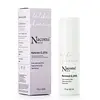What's inside
What's inside
 Key Ingredients
Key Ingredients

 Benefits
Benefits

 Concerns
Concerns

 Ingredients Side-by-side
Ingredients Side-by-side

Water
Skin ConditioningGlycerin
HumectantCaprylic/Capric Triglyceride
MaskingCoco-Caprylate/Caprate
EmollientCetearyl Isononanoate
EmollientIsoamyl Laurate
EmollientCoco-Caprylate
EmollientBakuchiol
AntimicrobialCetearyl Alcohol
EmollientGlyceryl Stearate
EmollientHydrogenated Coco-Glycerides
EmollientHydroxypropyl Starch Phosphate
Cetearyl Olivate
Retinyl Palmitate
Skin ConditioningHelianthus Annuus Seed Oil
EmollientTocopherol
AntioxidantSorbitan Olivate
EmulsifyingSclerotium Gum
Emulsion StabilisingCitric Acid
BufferingCaprylyl Glycol
EmollientPhenoxyethanol
PreservativeWater, Glycerin, Caprylic/Capric Triglyceride, Coco-Caprylate/Caprate, Cetearyl Isononanoate, Isoamyl Laurate, Coco-Caprylate, Bakuchiol, Cetearyl Alcohol, Glyceryl Stearate, Hydrogenated Coco-Glycerides, Hydroxypropyl Starch Phosphate, Cetearyl Olivate, Retinyl Palmitate, Helianthus Annuus Seed Oil, Tocopherol, Sorbitan Olivate, Sclerotium Gum, Citric Acid, Caprylyl Glycol, Phenoxyethanol
Water
Skin ConditioningGlycerin
HumectantCetyl Alcohol
EmollientPanthenol
Skin ConditioningCetearyl Alcohol
EmollientGlyceryl Stearate
EmollientCoco-Caprylate/Caprate
EmollientStearic Acid
CleansingGlycine Soja Oil
EmollientRetinol
Skin ConditioningHydrolyzed Glycosaminoglycans
HumectantSodium Hyaluronate
HumectantCitrus Aurantium Amara Flower Extract
RefreshingJasminum Officinale Flower Extract
MaskingLavandula Angustifolia Flower Extract
CleansingPaeonia Officinalis Flower Extract
TonicPrunus Serrulata Flower Extract
Skin ConditioningSambucus Nigra Flower Extract
RefreshingHyaluronic Acid
HumectantHydrolyzed Hyaluronic Acid
HumectantSodium Hyaluronate Crosspolymer
HumectantRosa Damascena Flower Oil
MaskingHelianthus Annuus Seed Oil
EmollientRaspberry Ketone
MaskingTocopheryl Acetate
AntioxidantBenzyl Alcohol
PerfumingSodium Lauroyl Glutamate
Polysorbate 20
EmulsifyingPropanediol
SolventDehydroacetic Acid
PreservativeBenzyl Glycol
SolventEthylhexylglycerin
Skin ConditioningWater, Glycerin, Cetyl Alcohol, Panthenol, Cetearyl Alcohol, Glyceryl Stearate, Coco-Caprylate/Caprate, Stearic Acid, Glycine Soja Oil, Retinol, Hydrolyzed Glycosaminoglycans, Sodium Hyaluronate, Citrus Aurantium Amara Flower Extract, Jasminum Officinale Flower Extract, Lavandula Angustifolia Flower Extract, Paeonia Officinalis Flower Extract, Prunus Serrulata Flower Extract, Sambucus Nigra Flower Extract, Hyaluronic Acid, Hydrolyzed Hyaluronic Acid, Sodium Hyaluronate Crosspolymer, Rosa Damascena Flower Oil, Helianthus Annuus Seed Oil, Raspberry Ketone, Tocopheryl Acetate, Benzyl Alcohol, Sodium Lauroyl Glutamate, Polysorbate 20, Propanediol, Dehydroacetic Acid, Benzyl Glycol, Ethylhexylglycerin
Ingredients Explained
These ingredients are found in both products.
Ingredients higher up in an ingredient list are typically present in a larger amount.
Cetearyl alcohol is a mixture of two fatty alcohols: cetyl alcohol and stearyl alcohol. It is mainly used as an emulsifier. Emulsifiers help prevent the separation of oils and products. Due to its composition, it can also be used to thicken a product or help create foam.
Cetearyl alcohol is an emollient. Emollients help soothe and hydrate the skin by trapping moisture.
Studies show Cetearyl alcohol is non-toxic and non-irritating. The FDA allows products labeled "alcohol-free" to have fatty alcohols.
This ingredient is usually derived from plant oils such as palm, vegetable, or coconut oils. There is debate on whether this ingredient will cause acne.
Due to the fatty acid base, this ingredient may not be Malassezia folliculitis safe.
Learn more about Cetearyl AlcoholCoco-Caprylate/Caprate is created from fatty coconut alcohol, caprylic acid, and capric acid.
It is a lightweight emollient. Emollients create a thin barrier on the skin to trap moisture in. This helps keep your skin hydrated and soft.
Once applied, Coco-Caprylate/Caprate is absorbed quickly and leaves a silky feel.
Coco-Caprylate/Caprate may not be fungal acne safe.
Learn more about Coco-Caprylate/CaprateGlycerin is already naturally found in your skin. It helps moisturize and protect your skin.
A study from 2016 found glycerin to be more effective as a humectant than AHAs and hyaluronic acid.
As a humectant, it helps the skin stay hydrated by pulling moisture to your skin. The low molecular weight of glycerin allows it to pull moisture into the deeper layers of your skin.
Hydrated skin improves your skin barrier; Your skin barrier helps protect against irritants and bacteria.
Glycerin has also been found to have antimicrobial and antiviral properties. Due to these properties, glycerin is often used in wound and burn treatments.
In cosmetics, glycerin is usually derived from plants such as soybean or palm. However, it can also be sourced from animals, such as tallow or animal fat.
This ingredient is organic, colorless, odorless, and non-toxic.
Glycerin is the name for this ingredient in American English. British English uses Glycerol/Glycerine.
Learn more about GlycerinGlyceryl Stearate is a mix of glycerin and stearic acid.
It is used to stabilize the mixing of water and oil ingredients. By preventing these ingredients from separating, it can help elongate shelf life. It can also help thicken the product's texture.
As an emollient, it helps soften skin and supports barrier-replenishing ingredients.
In cosmetics, Glyceryl Stearate is often made from vegetable oils or synthetically produced.
This ingredient may not be fungal-acne safe
Fun fact: The human body also creates Glyceryl Stearate naturally.
Learn more about Glyceryl StearateHelianthus Annuus Seed Oil is the oil derived from the seeds of a Sunflower. Sunflower seed oil is non-fragrant. It is an emollient, meaning it helps to soften the skin.
Sunflower seed oil contains many fatty acids. The fatty acids found in sunflower seeds include (from highest amount to least): linoleic acid, myristic acid, palmitic acid, stearic acid, arachidic acid, oleic acid, and linolenic acid.
These fatty acids help the skin create ceramides. Ceramides play a role in repairing the skin barrier.
Helianthus Annuus Seed Oil helps moisturize the skin. This in turn helps the skin look more rejuvenated and smoother.
Sunflowers are rich in vitamin E.
Historians believe Indigenous cultures of North America domesticated sunflowers before corn. Thus they relied on sunflower oil for a variety of uses. One such use is moisturizing skin and hair.
Sunflower seed oil may not be fungal acne safe. We recommend speaking with a professional if you have any concerns.
Learn more about Helianthus Annuus Seed OilWater. It's the most common cosmetic ingredient of all. You'll usually see it at the top of ingredient lists, meaning that it makes up the largest part of the product.
So why is it so popular? Water most often acts as a solvent - this means that it helps dissolve other ingredients into the formulation.
You'll also recognize water as that liquid we all need to stay alive. If you see this, drink a glass of water. Stay hydrated!
Learn more about Water